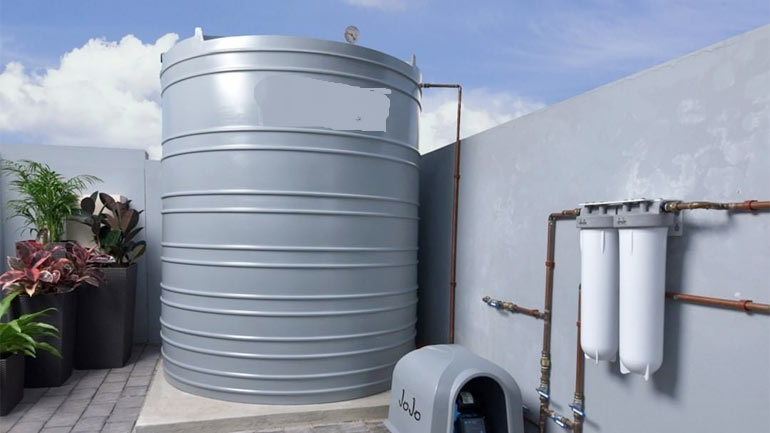Rainwater tanks are becoming an increasingly popular home improvement, and not just for people in rural areas. As water becomes harder to come by, and mains water prices slowly increase, people are turning to rainwater harvesting as an option to become a bit more self-sufficient, perhaps even save on their water bill, and use a water storage tank to support their way of life.
One barrier to entry for many people is not knowing what water tank company is most suited to their needs. There are dozens of places you can purchase a water tank these days, and that’s without getting into the differences between the types of water tanks available.
These types of water tanks include:
- Poly Tanks or Polyethylene Tanks (sometimes known as plastic tanks)
- Steel Water Tanks
- Zincalume® water tanks
- Colorbond® water tanks
- Stainless steel tanks
- Concrete Tanks
- Fibreglass Tanks
The most common tank material of these you will most likely be looking to install is a Poly Water Tank or a Steel Water Tank, and these are the two types of water tanks the majority of water tank companies offer.
The more outdated concrete tank, stainless steel water tank, and fiberglass tanks are used more in a commercial or industrial setting rather than for home water supply, with even the stainless steel tank being overlooked for a standard steel water tank in most scenarios.
Water tanks for indoor or outdoor use
An important factor to look at before choosing a water tank company is where you intend to use the water. If you’re just looking to install a smaller tank to water the garden and wash the car, you’d most likely be looking at a plastic water tank or even a slimline tank that won’t take up much room.
If the water tank is going to be for indoor use, particularly potable water – more commonly known as drinking water – then the water quality is going to be of more concern. Most plastic water tank companies make their tanks from UV-resistant, food-grade plastic, and the bladder tanks made from metal have inside of them is usually made from a similar material.
A Pioneer Water Tank takes this one step further, by installing an antimicrobial water tank liner which helps you have clean, fresh water thanks to the liner being made with silver ions, which help to prevent the build-up of microbes on the tank wall.
What size rainwater tank do I need?
Once you know what you’re going to be using your water for, you can then determine what tank size you need. A water storage solution that provides for the entire home’s water supply would typically call for a large tank, such as your Colorbond® or Zincalume® steel tanks. One of the major benefits of a steel rainwater tank is that they can be manufactured to a much larger size, which means that for the amount of storage that would require multiple tanks if you were using poly tanks, you would only require one steel tank.
The same is true in reverse though, in sizes that you only need one plastic tank, it would typically be easier to install than a steel water tank, as plastic water tanks can be easily rolled off of a truck and hooked up to the desired area of the home much quicker and cheaper. This is true for a round tank or slimline tank when looking at storage of less than 50,000L.
For a family of four relying on rainwater harvesting as their sole source of water, the best water tank size recommended is upward of 150,000L. This is however going to be dependent on how much water is going to be used for irrigation, and also on how much annual rainfall you receive.
An easy formula for determining how much rainfall you can harvest – this can be from your house roof, shed roof, or even from the tank roof with a smart gutter system – is to multiply your annual rainfall in mm, by your total catchment area.
Total Annual Rainfall (mm) x Total Rainwater Catchment Area (m2)
=
Annual Rainwater Harvesting Potential (L)
There are some options in the market for underground tanks, which can be great for places with very limited space, however, an above-ground tank is the best option for water pressure without requiring a submersible pump or any plumbing that is hard to access.
Rainwater tank prices
The main influence on rainwater tank prices is going to be the tank material you decide to go ahead with. If you’re looking at upward of 60,000L of water storage, then the prices of steel water tanks will often be more attractive, due to requiring multiple poly water tanks to do the same job.
For tank sizes 50,000L or less, you will likely find that a Poly Rainwater Tank is your best choice in terms of both price and ease of installation. Where a steel water tank will take a whole day to install – possibly not including plumbing – a poly water tank will be installed and ready to go much faster than that.
Other costs involved with installation will include installing a sad pad – particularly for steel water tanks – any electrical work that may need to be done for pumps, and any plumbing if a certified plumber is required to hook the tank up to your home.
You may also look into some accessories for your tanks, such as a water level indicator, vermin seal, fire valves, or many other options that can be added at the time of installation or aftermarket. These will also influence the overall price of your water storage system. Typically more accessories are offered with steel water tanks than poly tanks.
Long term prospects
Once you have figured out what size tank you need, what you’re going to be using your water storage for, and what you want your tank to be made out of; your list of rainwater tank manufacturers and installers will be considerably smaller.
Usually, you’ll look for something local, so they know the area, and you can hopefully keep your lead times and travel costs low, which may help you narrow it down slightly further. But what sets it apart from the last companies?
Warranty length
It might seem obvious that the length of a warranty is important, but even if it isn’t an indicator of the quality of the product – which it usually is – it will help give you peace of mind that even if something does go wrong, you have the backing of the manufacturer to get it repaired or replaced.
Companies with much shorter warranty lengths often don’t have as much confidence in the long-term durability of their product, be it due to quality or due to lack of available evidence. You want to be looking at a 20-year warranty on your water tank.
Company age
The age of the company may seem like an insignificant fact, but the longer a company has been producing and selling water tanks, likely the better quality they are. It also helps provide support to the warranty, as a company whose warranty is longer than the company itself cannot truly know that their tanks last as long as the warranty suggests.
There is also the fact that you risk a very new company going under, and having no support for your water storage solution over its service life.
Get out there and start your water storage journey
Now that you’re armed with the information that will help you make your decision, you can look at:
- Where are you going to be using the water?
- How much water are you going to be using?
- What size water tank will you need?
- Will you need a steel tank or a poly tank?
- What accessories might you want in your tank?
From here, you will have a smaller list of providers, who you can then look into for:
- Length of warranty
- Customer reviews and rating
- Company age and history
These key points will guide you in the right direction, and you can start getting quotes, and from there find the best priced and best quality tank for you.



